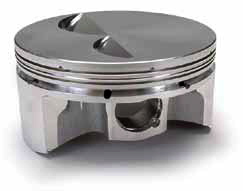
CHANGES IN PISTON DESIGN
Last month we discussed changes in piston ring design. Changes in rings also mean changes in the pistons they ride on. A century ago you could find cast iron pistons in your motor. Aluminum soon proved to be a lighter weight and more durable material to cast pistons from. Pistons didn’t really change much for the next 60 years. The new lightweight, fuel efficient, electronically controlled engines have brought many changes to piston and ring design that allow some of today’s engines to stay on the road for well over 200,000 trouble free miles. LIGHTER PISTONS -Reduced weight by reducing compression height, or the distance from the piston pin to the top of the piston -A reduced section thickness produces a lighter piston -A smaller or shorter skirt and less contact area also reduces a pistons weight HARD ANODIZED TOP RING GROOVES -Hardening the ring groove reduces wear -Eliminates micro-welding between piston and ring REDUCED RING GROOVE BACK CLEARANCE -Improves ring stability and reduces blow-by NARROWER RING GROOVES -A shorter compression height necessitates narrow rings to fit between the pin and piston crown -Narrower rings allow for less tension or drag -A smaller ring pack is a lighter ring pack.
ENGINE PRO TECHNICAL COMMITTEE
with thanks to HASTINGS PISTON RING COMPANY
February, 2014